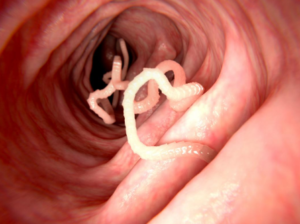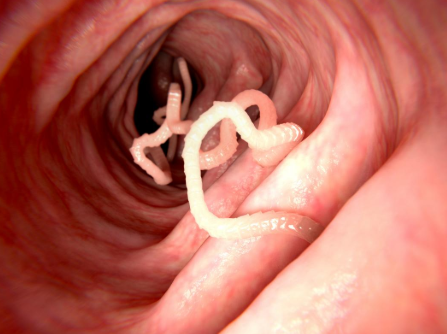White spots or specks in stool could mean a number of possible things. It could be candida or any other underlying medical condition. What are these seed- like specks in your stool? Discover important facts about this condition in this article.

The color, texture, and composition of your stool say a lot about your health and digestive system. White spots or speck n stool is certainly one of such symptoms. This condition is not normal and when it occurs it could be a sign or a symptom of a different condition. Urgent medical diagnosis is required if the specks or spots persist for more than a week.
In this topic, we discus some of the common possible case of the white specks in stool, what the color of your stool mean and how you can treat some of this conditions.
White spots, specks in stool meaning
What does it mean to have white specks in stool? In a medical diagnosis or examination, the color, texture, and appearance of one’s stool can say a lot about a person’s general health. White specks in stool are not normal, it if you notice any such thing, see your doctor as soon as possible.
The color and characteristics of your poop may change every now anything due to different reason. Some are serious whereas others are serious and need to be attended on as soon as possible. What you eat will certainly have a great impact on the color, and texture of your poop. Similarly, how healthy your body is will also influence some of these characteristics.
So what do white spots or specks in stool really mean? We recommend seeing your health care provider to help establish what the underlying cause might be. If the specks appear on once then disappears, it’s more likely that the cause is nothing to worry about. However, when the specks continue to appear, it can be a sign of something serious that requires urgent medical attention.
Some of the possible cause of white specks in poop are discussed below.
What causes white spots or specks in stool?
The color, texture and other characteristics of you poo speaks volumes about your overall health. We recommend actually looking at the poop before flushing it away. Doctors and other medical practitioners can use your stool to tell them about your immune system, your levels of stress, how hydrated your body is and whether or not your body is receiving all the nutrients it requires.

It is believed that your bowel movement is made up of ¾ water and the remaining fraction being a combination of fiber, bacteria, mucus and other body cells. Doctors add that the color of your poop goes a lot farther than just the shape and texture. The color is also a great indicator of some of these conditions. So what does the presences of white specks in stool really mean?
The color of a healthy stool will often range from light dark brown to occasionally green depending on what you eat. White specks or spots in stool are likely to signs of any other following:
1. Bile deficiency
For a healthy person, the color of the stool of often brown, this is because it contains bile juice produced in the liver that aids in the digestion of fat in your diet. A problem with the liver that affects the efficient production of bile can result in some changes in the color of your poop.
Bile deficiency could be caused by diseases such as cirrhosis, hepatitis. Other times the deficiency can be caused by a problem with the gallbladder.
2. Hepatitis
This is a disease characterized by the inflammation of the liver. In some people no symptoms are seen whereas in others symptoms of this condition will include:
- Yellow discoloration of the skin
- Poor appetite
- Vomiting
- Abdominal pain
- Diarrhea
The inflammation of the tissue of the lung can affect the production of bile which is essential in digestion, this may, therefore cause white specks in stool as undigested foods.
3. Cirrhosis
This is a chronic disease of the liver marked by degeneration of cells, inflammation, and fibrous thickening. It is a common condition in heavy drinkers and those with hepatitis, like hepatitis, liver cirrhosis may affect bile production which is essential for digestion.
4. Cholecystitis
Cholecystitis is the inflammation of the gallbladder found below the liver whose main function is to store and concentrate bile. The gallbladder also drains waste products from the liver into the duodenum.
5. Gallstone
A gallstone is a small, hard crystalline mass formed in the gallbladder (bile duct) from bile pigment cholesterol or calcium salt. Gallstone causes severe pain and may block the bile duct thus affecting proper digestion of fat.
The gallbladder is connected to the release of bile from the liver via a duct. A gallstone may block this duct causing lack of bile in the digestive system which can be shown by white specks in stool.
6. Pancreatitis
This is the inflammation or the infection of the pancreas. In digestion, the pancreas produces some enzymes that work with other digestive enzymes to digest and process sugar.
The inflammation or infection of this organ may hinder the efficient digestion of fats and sugar which may end up as white specks of undigested foods in your stool.
7. Biliary atresia
Biliary atresia is a liver malfunction that causes a deficiency of bile in the digestion of fat. Biliary atresia is a birth defect that causes one of the ducts connecting the liver to the gallbladder to be blocked. This is what stops the flow of bile between the liver and the gallbladder.
8. Using certain medication
It is not uncommon to notice some colored specks in stool after using some medication. A common such medicine is antacid which contains aluminum hydroxide that can affect the color of your stool.
In rare cases, the white seed like specks you notice may be capsules of certain antibiotics. See you doctor as soon as possible in such cases.
9. Celiac disease
Celiac disease causes the small intestine to lack the ability to digest certain nutrients, most specifically gluten. It is an autoimmune system disorder that occurs when your immunes system attacks your small intestine cells. When suffering from this condition, the undigested food may end up in your stool as white specks.
10. Candida yeast infection
White spots in stool can also be a sign of a yeast infection. Weak or compromised immune system or taking a course of antibiotics may lead to the over growth of candida Albicans, which can be shown by the presences of white lumpy spots in stool.
Candida yeast infection can also be shown by increased cravings for sugar, itching around anus and in vagina among others.
When this is the cause of the white stool, then treatment may involve boosting your immune system by eliminating sugar, alcohol and refined carbohydrates. Increase your consumption of organic vegetables such as carrots, spinach, asparagus, and kales.
11. Parasitic infection
Parasitic infection is a common cause of abnormal poop color. Parasites such as worms (tapeworms) may appear as white lumps in stool.
In cases of a parasitic infection, you are also likely to have other symptoms such as:
- Nutritional deficiency
- Abdominal pain and cramps
- And other digestive problems
- Bloating
- Diarrhea
- Vomiting and nausea
12. Lactose intolerance
Lactose intolerance means the body cannot digest lactose, a type of sugar found in milk and other dairy products. If you are suffering from this condition, then you are likely to notice the white specks after eating foods such as milk, butter, cheese.
13. Mucoid stools
Mucus in the stool may cause your stool to appear white or with white specks. Normally, the inner lining of your intestine or digestive system produces mucus due to an allergy, an infection or an inflammation. During a bowel movement, the excess mucus produced may cause your stool to appear whitish.
White specks in stool in children
White stool can occur in both children and adults. Normally, children often have all sort of stools. Most are perfectly normal and due to food, they eat. According to Mayo Clinic gastroenterologist, white stool or specks in stool is something to be examined as soon as possible.
Like in adults, white stool can be caused by the inability of bile to reach the stool. This can be caused by the inability of the liver producing enough bile or as a result of something blocking the bile from reaching the small intestine.
According to the American academy of pediatrics, if your child is on a milk diet, taking antibiotics, antifungals, or antacids may cause him or her to have white stool.
As mentioned, white stool in children is often a sign of a serious condition such as a problem with the liver, gallbladder or the small intestine. A common condition that might lead to such symptoms includes liver infections, sclerosing cholangitis, and inborn metabolism errors among others.
White spots in stool candida
Candida is a common type of yeast infection. In humans, candid is considered a natural fungus which helps your body digest food and absorb nutrients. For those with a weak or compromised immune system, white flecks in stool are quite common. This can be a sign of candida overgrowth a condition known as candidiasis, the white flecks in such cases are believed to be clusters of fungi.
Candida or yeast overgrowth will often times results in symptoms such as fatigue, skin problems brain fog among others.
The “good” bacteria in the body helps keep the yeast in check. High consumption of sugar, carbohydrates, and antibiotics may end up killing and reducing the number of these “good” bacteria causes the fungus to get out of hand. Other causes of candida overgrowth will include emotional stress, high alcohol consumption, and taking oral contraceptives.
Apart from the white specks in stool, candida overgrowth can be shown by the following symptoms:
- Fungal infection on skin and nails
- Seasonal allergies
- Outbreak of autoimmune disorders
- Fatigue
- Bloating, constipation or diarrhea
- Anxiety and mood swings
- Difficult concentrating or brain fog
There are some simple tests that can be used to determine the level of these fungi in the body. Some of these tests include complete blood count, stool testing, and urine organix test. After this has been done, your doctor will then be in a position to prescribe the best treatment for the condition.
Treating candida involves stopping the yeast overgrowth. Treatment will, therefore, involve restoring the friendly bacteria that help keep the fungi in check. In some cases, the treatment will also involve healing the gut to stop candida from entering your bloodstream.
White spots in stool constipation
You are said to be constipated when you have hard or infrequent bowel movements. Normally constipation occurs when stool or digestive waste moves too slowly through the digestive tract. Constipation can also occur when you are unable to effectively empty your bowel. This causes the stool to become dry and hard.
Constipation can be caused by a blockage in the colon or rectum, nerves around the anus, or other condition that affect your body hormones. Other causes include colon cancer, eating disorders, irritable bowel syndrome, excessive use of laxatives and emotional stress.
Chronic constipation can be shown by the following symptoms:
- Having less than three bowel movements per week
- Hard, dry and lumpy stool
- Excessive straining during a bowel movement
- Painful or swollen belly
- Vomiting
- When constipated, you need to do the following:
- Drink plenty of water and fruit juice to remain hydrated
- Increase your fiber intake
- over the counter stool softener and laxatives can be used to soften the stool
- Call your doctor if you develop sudden constipation, belly pain, and cramping.
White seed like spots in stool
Often times, white seed like spots can simply be undigested food. This is especially true after eating fruits and cereals. If the spots occur once or twice then clears then you could dismiss it as undigested food, however, if they continue to appear or are accompanied by other symptoms, then you may need to have your health care provider check them up as soon as possible.
Parasites and worms such as tapeworms in stool can also appear as white specks in stool. Parasitic infection can result in a nutritional deficiency, and pain in the abdomen, the white seed like specks in stool could more likely be the parasite itself enclosed in a layer of inflammatory mucous.
How to treat white spots or specks in stools
Like with many symptoms, treating the underlying cause is often the best way to treat, clear and get rid of the symptom. From our discussion, it is true that white specks in poop can be a sign of different conditions that need to be identified and treated as soon as possible.
When white specks occur once in stool then disappears, you can brush it off as nothing to worry about, however, if you spot the specks regularly in more than three bowel movements, then that is something that should be checked and treated as soon as possible.
Treating white specks in stool involves treating the underlying cause of the condition. For instance, if the cause of the white specks is lack of bile, then treating the condition will certainly involve correcting this situation. Your doctor may need to examine your liver and gallbladder to confirm this condition.
On the other, if the specks are a side effect of certain medication, your doctor may change them medication by prescribing others.
Maintaining a proper diet with adequate amount of fiber and water may help prevent dehydration and get rid of other characteristics such as: hard or soft stool, constipation, among others.
References:
- https://healdove.com/disease-illness/white-spots-in-stool
- http://buddymd.com/causes-white-spots-stools
- http://www.huffingtonpost.ca/2016/02/02/what-you-poo-is-telling
- https://www.enkiverywell.com/white-balls-in-stool.html
- http://www.healthyandnaturalworld.com/white-specks-in-stool/


